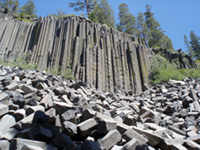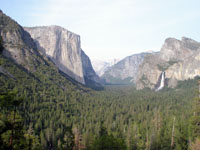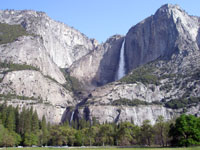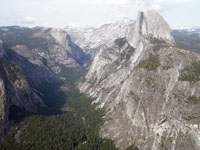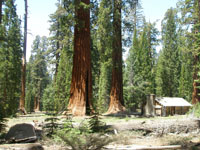
Regional Geology of North America |
Sierra Nevada Province |
Click on images for a |
| The Sierra Nevada Range is the ancestral equivalent of the modern Cascade Range, but it has a significantly different geologic history. The rocks exposed in the core of the Sierra Nevada range are granitic rocks that crystallized in intrusive bodies beneath a volcanic arc system associated with a subduction zone between the Farallon Plate and the North America Plate in Triassic to Cretaceous time. In Late Cretaceous time as the North American Plate rapidly overrode the Farallon Plate, ending subduction in the Sierra Nevada region. By mid Tertiary time, the Sierra Nevada was a low upland region, and rivers flowed from Nevada across the region—carrying the gold mined that was eventually mined from the gravels on the western side of the Sierra Nevada Range during the California Gold Rush. The Sierra Nevada suddenly began to rise and till westward starting about 4 million years ago. The eastern side of the Sierra has a long series of great normal faults, producing a steep range front that marks the western boundary of the Great Basin. Volcanism followed, producing massive volcanic features associated with Mammoth Mountain volcano and the supervolcano, Long Valley Caldera (20 miles long and 11 miles wide,) that produced a massive eruption 760,000 years ago. The region is sit very geologically active, having both numerous earthquakes and signs of subsurface volcanic activity. Devils Postpile National Monument famous for its columnar jointed lavas exposed in a canyon along the eastern side of the Sierra Nevada Range (Figure242). Yosemite National Park and Sequoia-Kings Canyon National Park encompass the mountainous terrane in the high country of the Sierra Nevada. The spectacular scenery is a result of the erosion of glaciers that blanketed the high Sierra during the Pleistocene ice ages. Valley glaciers carved the U-shaped, steep rock walled canyons in the parks (Figures 243 to 246). The eastern Sierra is host to redwood forests that Sequoias (Sequoiadendron giganteum; world’s largest tree, by volume, Figure 247). In comparison, Coast Redwoods (Sequoia sempervirens) are the world’s tallest tree. The eastern Sierra is the only natural habitat for the Sequoias. |
|
 Figure 243. Airliner view of the Sierra Nevada over Yosemite National Park, California. |
| https://gotbooks.miracosta.edu/geology/regions/sierra_nevada.html 1/20/2017 |
